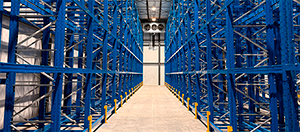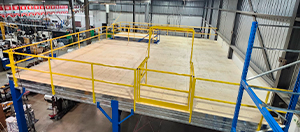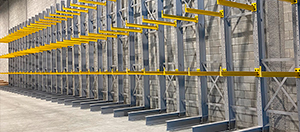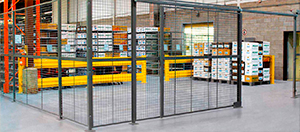Different parts and their specifications
Racking
They are usually made from hot-rolled steel profiles of different shapes (poles, angles, etc.). The thickness and dimensions of these profiles are determined according to the loads to be borne and the height of the structure:- Upright :
- Hot-rolled "I" or "H" profiles.
- Thickness varies depending on the height and load, usually between 2 and 5 mm.
- Perforations along the entire length for adjustment of the slides.
- Galvanized coating for corrosion protection or painted.
- Hot rolled "C" or "Z" profiles.
- Thickness usually between 1.5 and 3 mm.
- Nesting on the uprights for quick and easy assembly.
- Galvanized or painted coating.
- Galvanized or painted steel tubes.
- Attached to the posts to prevent pallet drops.
- Galvanized or painted steel elements to assemble uprights and rails.
Mezzanine
They can be made of galvanized steel or sheet steel with a non-slip coating to ensure the safety of users.- Posts:
- Hot rolled "H" or square tube profiles.
- Variable dimensions and thicknesses depending on the load and height of the mezzanine.
- Anchor plates for floor mounting.
- Hot-rolled "I" or "H" profiles.
- Variable dimensions and thickness depending on the range and load.
- Wood panels (agglomerated, OSB), galvanized steel or grating.
- Thickness and type of coating chosen according to the intended use.
- Galvanized or painted steel posts and rails.
- Filled with wire mesh, perforated sheet or solid panels.
Cantilever
They are subject to high stresses and are often made of high-strength steel to prevent deformation under load.- Columns, Base and Arm:
- Hot-rolled "I" or "H" profiles, often reinforced by stiffeners.
- Variable dimensions and thickness depending on the range and load.
- Attachment to the posts by specific connectors.
- Steel elements (tubes, cables) to ensure the stability of the structure.
Mesh partitions
They are usually made from steel wires welded together to form a wire mesh. The wire diameter and mesh size are selected according to the required safety level.- Panels:
- Galvanized or laminated steel wires welded together to form a wire mesh.
- Wire diameters and mesh sizes vary according to the required safety level.
- Galvanized or painted steel tubes.
- Fixed to floor and ceiling to hold panels.
- Galvanized or painted steel frame with wire mesh filling.
- Lock or padlock.
Important remarks:
- Exact part specifications may vary depending on manufacturers and applicable standards.
- It is crucial to consult a qualified professional for the design and installation of these structures in order to ensure safety and compliance with standards.
- The use of high quality steel and protective coatings (galvanizing, painting) is essential for durability and corrosion resistance.
- Any changes to the structure (for example, adding levels, changing configuration) must be subjected to a new stress analysis and approved by a structural engineer.
- Regular inspections shall be carried out to detect any damage or signs of weakness (for example, deformation, cracks, corrosion).
- Preventive and corrective maintenance must be performed to ensure the durability and safety of the structure.

_293.png)
_785.png)
_282.png)




_228.png)